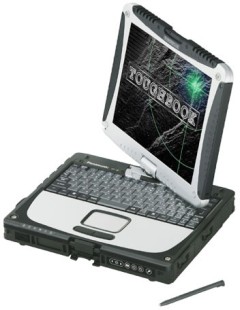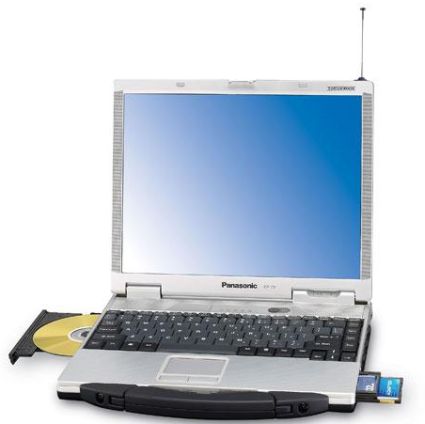 If you’ve watched any spy thriller movies and action-oriented television shows lately, you would notice the thick, rubber-padded, ruggedized laptops that either the baddies or the good guys tote with them to take care of their high tech needs. Take Mission Impossible, for instance. I distinctly remember scenes in MI2 and M:I:III where I spotted ruggedized laptops. I suppose they survived explosions–or at least the data inside them on hard discs did.
If you’ve watched any spy thriller movies and action-oriented television shows lately, you would notice the thick, rubber-padded, ruggedized laptops that either the baddies or the good guys tote with them to take care of their high tech needs. Take Mission Impossible, for instance. I distinctly remember scenes in MI2 and M:I:III where I spotted ruggedized laptops. I suppose they survived explosions–or at least the data inside them on hard discs did.
Of course, there are plenty of applications for tough laptops in real life, and yes, they do include scenarios depicted on film. So spies, policemen, firemen and even sailors do get to use rugged laptops in the course of doing their jobs.
Rugged laptops were specifically designed to withstand an inordinate amount of stress. From the dusty heat of the summer desert to the crashing waves of a stormy sea, these extreme machines offer high-performance usability every time. Water resistant, dust/sand resistant and shockproof, rugged laptops are utilized by the military under virtually all environmental conditions. Their ability to maintain peak performance at temperatures of -10 degrees Fahrenheit to +140 degrees Fahrenheit, in addition to their durability when dropped or struck, makes these devices all but invincible. – laptopical
From use in various challenging and potentially hazardous situations such as the battlefield, construction sites, and at sea, on sand, or even the corporate boardroom, tough latops do have their place in the computing world. They’re either beefed up notebook models or laptops designed from scratch to withstand extreme circumstances.
What would constitute a rugged or tough laptop? According to whatlaptop, a rugged laptop should have the following characteristics.
- Should be able to withstand extreme temperatures. A tough laptop should be protected against extremes of heat or cold.
- Should be liquid-proof. A tough laptop should have an exterior that protects the innards from liquids, whether from light rain to high levels of humidity, even from some immersion up to certain depths.
- Should be dust-proof. A tough laptop’s exterior shouldn’t let any dust or other such particles enter the computer’s insides.
- Should be shockproof. A tough laptop should be able to withstand shaking, bumping and even dropping up to certain heights.
- Should be able to withstand proximity to hazardous materials. Sometimes the workplace has corrosive and even flammable substances that can damage the laptop. A tough notebook should be able to work near these substances without damage.
You might think you would have to contend with poor performance just to get a rugged laptop. However, this isn’t necessarily true. Today’s rugged laptops are as good as their more conventional counterparts in terms of processing performance. Sometimes they’re even better, such as in the case of battery life (after all, your tough notebook won’t be any good in the field if it doesn’t have power).
For instance, the Panasonic ToughBook CF-18 (pictured above) is both tough and feature-rich.
… the CF-18 is designed to be used in the field, quite literally, the anti-reflective 10.4 inch, 65K colour, display has been designed to be daylight viewable. Depending on the requirement of the user the type of touch-screen can be altered to either be stylus and pressure sensitive, so anything can be user to move the cursor or electronic stylus dependant so only a specially supplied pointing device will be compatible. Regardless, a tethered stylus is supplied and is stored in the bottom left hand side of the screen. The display is rotated by disengaging the catch at the rear of the keyboard and rotating the screen clockwise through 180 degrees and closed over the keyboard, being locked in place by the main catch. Once in position the stylus comes into use, as do the bank of tablet control buttons located on the front right of the main catch. – Pocket Lint
Also, if you’re not much into the outdoors, but you would still prefer your laptop to be tough and rugged, you can opt for such models like the ToughBook CF-74, which is the less rugged series in the line. It’s more attuned to the urban jungle (corporate boardrooms, perhaps) rather than the field, but these notebooks still offer a considerable amount of protection against the elements (like coffee spills). The CF-74 features the latest Core Duo processor and has enough juice for 8 hours of work in between charges.
Just as you wouldn’t wear cowboy boots to a black-tie ball, you would probably never carry a rugged notebook into a mahogany-paneled boardroom. The Panasonic Toughbook CF-74 is an exception. This semi-rugged sytem is made for highly mobile people who are tired of replacing less-durable notebooks but want something that still looks, acts, and runs like a mainstream machine. – LaptopMagazine

… an “ultimate road warrior PC” that adds speed, a ton of battery life, and a little bit of weight to its predecessor. The CF-74 (or simply Toughbook-74) is an upgraded version of the company’s Toughbook-73 13.3-inch XGA model (pictured), and thus shares many of the same features (touchscreen, 512MB of RAM, shock-mounted hard drive, DVD combo drive, WiFi, optional EV-DO and Bluetooth), but jacks up the processor from a 2.0GHz Pentium M to a 1.83GHz Core Duo, more than doubles the maximum allowable RAM, and perhaps best of all, also more than doubles the battery life from 3 hours and 15 minutes to a claimed Mobile Mark-tested 7 to 8 hours. – Engadget
Rugged laptops do not come without drawbacks. First and foremost is the price. Panasonic’s ToughBooks can fetch prices of US$ 3,500 up, which is already at least twice the cost of most other Core Duo laptops, and can usually already buy you notebooks with higher specifications and performance. Then there’s the size. You can’t expect tough notebooks to be as sleek as regular ones (though they do come in light packages). But of course, if the job demands tough people and tough machines, rugged laptops such as ToughBooks are the only way to go.